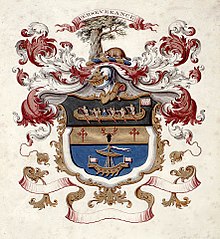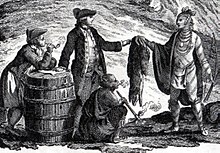Beaver Club

The Beaver Club was a
Origins



In 18th century North America, the fur 'barons' of Montreal might only have been compared to the tobacco 'lords' of Virginia for their wealth and grand style of living.[3] The members of the Beaver Club were bon vivants, renowned for the Scottish Highland hospitality they offered to their guests and for the jovial, rollicking behaviour that carried on at their meetings.[4] In his entertaining book The Shoe and Canoe, the English geologist, John Bigsby, relates the character of these Montreal fur traders in their early days:
A number of young men, chiefly of good Scotch families, able, daring, and somewhat reckless perhaps (a typical example being John MacDonald of Garth), formed themselves into a company (the North West Company) in order to traffic in the forbidden land (owned by the Hudson's Bay Company) in spite of the charter.
A first-rate Indian trader is no ordinary man. He is a soldier-merchant, and unites the gallantry of the one with the shrewdness of the other. Montreal was then the best place for seeing this class of persons.. They spend fast, play all the freaks, pranks, and street-fooleries, and originate all the current whimsicalities: but this is their brief holiday: when they turn their faces westward, up stream, their manners change.
The Indian Trader is a bold, square-chested, gaunt man, sun-burnt, with extraordinary long hair as a defence against mosquitoes. He is equally at home on horseback or in the canoe - indefatigable when needful, careless of heat and cold, and brave as steel, as though he bore a charmed life, in countries where the Queen's writ scarcely runs, where the law only of personal authority takes effect. Often he has not only to contend with the Indians, and to right himself on the spot with other traders, but he has to fight his own men hand to hand. Kindness, vigour, and sagacity, usually render but one such affair necessary.[5]
In 1786, controlled by
At
at their belts. In 1894, Brian Hughes recalled his grandfather (James Hughes, admitted a member of the club in 1813) recounting his memories of these partners journeying into the wilds:They traversed the rivers in great state, like sovereigns making a progress. They were wrapped in rich furs, their huge canoes freighted with every convenience and luxury and manned by Canadian voyageurs as loyal and as obedient as their own ancestral
clansmen. They carried with them cooks and bakers, together with delicacies of every kind, and an abundance of choice wine for the banquets.[6]: 72
The men of the Beaver Club had a great reputation for hospitality and generosity, which led to many of them frittering away their fortunes. One such example was
This too often happens with the gentlemen of the North-west company who retire from the concern. They emerge suddenly into civilized life after a banishment of many years in dreary forests and among a race of savages; and are apt to be dazzled by the glare of refinement and luxury, whose temptations are too powerful to be resisted. Hence they are frequently led into error and extravagance, which ultimately despoil them of their hard-earned property.[8]
Traditions


At first, the nineteen incorporators of the Beaver Club maintained a rigid exclusiveness over its membership, but later their ranks were opened and the limit of membership was placed at fifty-five with ten honorary places. At the regular gatherings an opportunity was offered of introducing into society such traders as might from time to time return from the Indian country. Potential members were selected by ballot on the basis of their standing and character and then invited as a guest to one of the gatherings. Following the dinner, a vote was taken and only if approved of unanimously would they then be invited to join the Club.
The first dinner of their season was held on the first Wednesday in December. Following that
Records are scant, but the guests known to have attended included
The dinners commenced at 4:00 in the afternoon. Members arrived richly adorned in ruffles and a profusion of
The start of the festivities were marked by the passing around of a
Seated around a great
After dinner, any previous formalities were laid aside as the men started to sing old voyageur songs and exchange tales about their perilous adventures in the old fur trading days. The festivities often ran into the early hours of the morning with the members dancing on the tables, re-enacting various
Dinner Bill
On 17 September 1808, nineteen members met at Richard Dillon's Montreal Hotel on the Place d'Armes. Those present were: Joseph Frobisher (presiding); Alexander Henry the elder (vice-chairman); William McKay (the 'cork'); Alexander McKay; William McGillivray; James McGill; Isaac Todd; Josiah Bleakley; John Gregory; George Gillespie; Roderick Mackenzie of Terrebonne; Thomas Thain; General Sir Gordon Drummond; Sir John Johnson; Sir Roger Sheaffe; John MacDonald of Garth; Archibald Norman McLeod; Alexander McKenzie (cousin of Sir Alexander Mackenzie); and John Jacob Astor.
The bill for this meeting was: 32 dinners (£12); 29 bottles of
Members



All the names below appeared in Rules and Regulations of the Beaver Club, 1819, when only one of the original members was still alive. The nineteen original members were ranked in seniority by the date on which they had first entered the interior of
- Charles Chaboillez (1751)
- Maurice-Régis Blondeau (1752)
- Hypolitte Desrivieres (1753)
- Etienne-Charles Campion (1753)
- Gabriel Cotte (1760)
- Alexander Henry the elder (1761)
- Joseph-Louis Ainsse (1762)
- Benjamin Frobisher (1765)
- James McGill (1766)
- George McBeath (1766)
- James Finlay (1766)
- Joseph Frobisher (1768)
- John McGill (1770)
- Peter Pond (1770)
- Matthew Lessey (1770)
- David McCrae (1772)
- John McNamara (1772)
- Thomas Frobisher (1773)
- Jean-Baptiste Jobert (1775)
New members were elected almost every year from 1787, though the dates of their first voyages into the interior were not always recorded. The list below shows new members inducted by year, and if known the year of their first voyage in brackets:
- 1787: Jean-Baptiste Tabean (1770) Josiah Bleakley.
- 1789: Patrick Small (nephew of Major-General John Small)
- 1790: Nicholas Montour (1767); Venant St. Germain; Leon St. Germain; Joseph Howard.
- 1791: John Gregory; Andrew Todd; Jacques Giasson.
- 1792: Simon McTavish.
- 1793: Myer Michaels; James Grant.
- 1795: Isaac Todd; William McGillivray; Sir Alexander Mackenzie.
- 1796: Angus Shaw; Roderick Mackenzie of Terrebonne.
- 1799: Duncan McGillivray; George Gillespie.
- 1801: Jacques Porlier.
- 1802: Alexander Cuthbert.
- 1803: Alexander Fraser; Simon Fraser.
- 1807: Dr. David Mitchell, Sr.; Thomas Thain; Lewis Crawford; David Mitchell, Jr., the younger; Peter Grant; Alex McDougall; Pierre de Rastel de Rocheblave (1793); John Forsyth; John Richardson; John Finlay; Aeneas Cameron; William McKay.
- 1808: Sir John Johnson; John MacDonald of Garth; Archibald Norman McLeod; Alexander Mackenzie (1783).
- 1809: John Wills; Charles Chaboillez, younger; Alexander McKay.
- 1810: John Sayer.
- 1813: James Hughes; Kenneth McKenzie.
- 1814: Archibald McLellan (who won an award for bravery); George Moffat; W. McRae; Henry McKenzie.
- 1815: Jasper Tough; J.M. Lamothe (1799); F.A. LaRocque; Thomas McMurray; Robert Henry; Peter Warren Dease; Charles Grant.
- 1816: David Stuart.
- 1817: William Henry; Jacob Franks (1799); David David (1807); John McLaughlin (1807); Hugh McGillis; John McDonald; Allan McDonell; James Grant; John Siveright (1799); John George MacTavish.
- 1818: Simon McGillivray; Angus Bethune; Jules-Maurice Quesnel; John McGillivray; James Leith.
- 1820: Sir George Simpson.
Finally, there were eleven honorary members, many of whom were the captains of the ships who transported their furs back to England. They could only attend at meetings held especially for them in the summer months. The dates in brackets show the year of their admission:
Captain Featonby of the Eweretta (1789); Captain Gibson of the Integrity (1789); Monsieur le Compte Andriani, of
Decline
As trading posts were built it had become less dangerous to travel in the wilderness, and without competitors' territories to invade, the early spirit of adventure had disappeared from newcomers to the fur trade. By 1809, the seventy-year-old Alexander Henry hinted at a segregation between the young and old members in a letter to John Askin: "There is only us four old friends (himself, James McGill, Isaac Todd and Joseph Frobisher) alive, all the new North westards are a parcel of Boys and upstarts, who were not born in our time, and supposes they know much more of the Indian trade than any before them".[13]
The club continued to meet until 1804, and there was a resurgence of interest between 1807 and 1824, but when
See also
References
- ^ a b Larry Gingras (1972). The Beaver Club Jewels.
- ^ a b c Douglas Mackay (1936). The Honorable Company, A History of the Hudson's Bay Company. Bobbs-Merrill Co., N.Y.
- ^ a b c William H. Atherton (1914). Montreal 1535-1914. Montreal: S.J.Clarke Publishing Co.
- Agnes Christina Laut (1900). Lords of the North. Toronto: W. Briggs.
- ^ a b John Jeremiah Bigsby (1850). The Shoe and Canoe. Canada: Chapman and Hall. p. 124.
beaver club bigsby.
- ^ a b Charles Bert Reed (1914). Masters of the Wilderness. University of Chicago Press.
- ^ Collections of the Massachusetts Historical Society for the year 1786 - Province of Quebec. 1786.
- ^ John Lambert (1808). Travels through Canada and the United States of North America.
- ^ George Ramsay, Earl of Dalhousie. Marjory Whitelaw (ed.). The Dalhousie Journals. Vol. 2.
- ^ Jo-Anne Fiske; William Wicken (1995). New faces of the fur trade: selected papers of the Seventh North American Fur Trade Conference. Halifax, Nova Scotia.
{{cite book}}: CS1 maint: location missing publisher (link) - ^ a b "Wintering Partners of the North West Company". McGill University of McGill. 2001.
- ^ Carolyn Podruchny. Making the Voyageur World: Travelers And Traders in the North American Fur Trade.
- ^ Milo Quaife (1931). The John Askin Papers.
- ^ Marjory Harper. Emigrant Homecomings: The Return Movement of Emigrants, 1600-2000.
